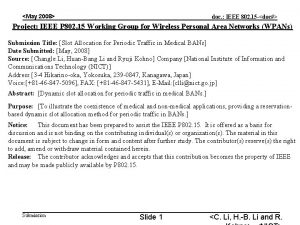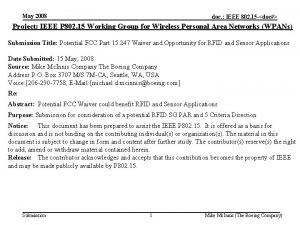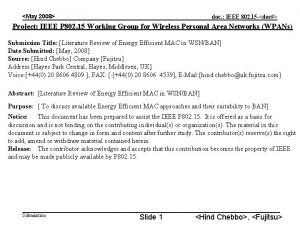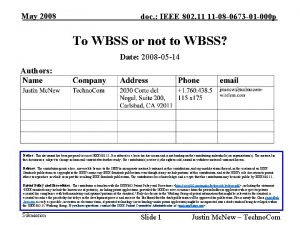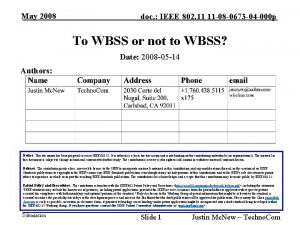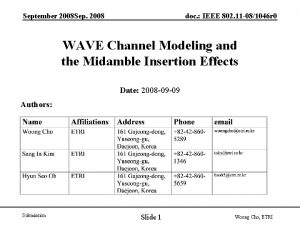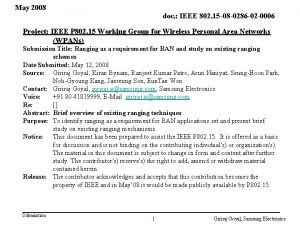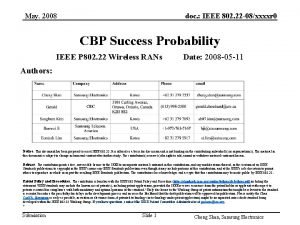May 2008 doc IEEE 802 15 15 08












- Slides: 12

<May 2008> doc. : IEEE 802. 15 -<15 -08 -365 -00 -0006> Hearing Aids: Cutting Edge Technology, In An Ultra Constrained Environment Jeff Solum May 14 th, 2008 Submission Slide 1 <Jeff Solum>, <Starkey

<May 2008> doc. : IEEE 802. 15 -<15 -08 -365 -00 -0006> Agenda • • • Hearing Aid (HA) Styles Hearing Aid Market Wireless and Hearing Aids: Why? Which Wireless? Adding Wireless: The Challenge Adding Wireless: Defining a Path HA Antennas: A Crucial Element Frequency of Operation Trade offs Summary Submission Slide 2 <Jeff Solum>, <Starkey Laboratories>

<May 2008> doc. : IEEE 802. 15 -<15 -08 -365 -00 -0006> Hearing Aid Styles Behind The Ear (BTE) On The Ear (OTE) BTE instruments have a plastic casing that rests behind the ear and houses the device's technology. A clear plastic tube then directs amplified sound into an earmold inside the ear canal. With soft, flexible earbuds and an extra-small casing, on-the-ear models are light and comfortable. Submission Receiver-In. Canal (RIC) In-The-Ear (ITE) In-The-Canal (ITC) Completely-In. Canal (CIC) The receiver-in-thecanal device is small, discreet, and incredibly quick to fit; perfect for many firsttime wearers. Smaller, in-the-ear instruments house their technology components in a custom-formed earmold that fits within the outer portion of the ear. In-the-canal instruments are smaller still, featuring an earmold that fits down into the ear canal and a smaller portion that faces out into the outer ear. These devices fit completely in the canal. Only the head of a tiny plastic line— with which you insert or remove the instrument—shows above the canal. Slide 3 <Jeff Solum>, <Starkey Laboratories>

<May 2008> doc. : IEEE 802. 15 -<15 -08 -365 -00 -0006> Hearing Aid Industry at a Glance • • Hearing is essential to fully enjoy and participate in life: – One in ten Americans — more than 31 million — experience some degree of hearing loss. – About 40% of hearing-impaired Americans are under the age of 65. – This makes hearing loss our third most prevalent chronic health condition, after arthritis and high blood pressure. Estimates place approximately 300 million people worldwide with hearing impairment. 90% of the worldwide production of hearing aids is controlled by 6 multi -national hearing aid conglomerates – Starkey, Widex, Siemens, Phonak, Oticon and GN-Resound. More than 90 percent of all hearing aids sold are digital. Submission Slide 4 <Jeff Solum>, <Starkey Laboratories>

<May 2008> doc. : IEEE 802. 15 -<15 -08 -365 -00 -0006> Hearing Aid Market at a Glance • According to the Hearing Industries Association (HIA), hearing aids dispensed in the United States during 2007 totaled 2. 42 million units. • BTEs now constitute 51. 4% of the overall US market. – BTE market share is accelerating toward the levels seen in Europe – For example, BTE market penetration is estimated at 83% in France and 89% in Germany Submission Source: Hearing Industries Association > Worldwide, approximately 6 -7 million hearing aid units are sold each year. Slide 5 <Jeff Solum>, <Starkey Laboratories>

<May 2008> • doc. : IEEE 802. 15 -<15 -08 -365 -00 -0006> Wireless and Hearing Aids: Why? Programming of Digital Data – Optimizing signal processing parameters – Real-time audio response • USB 1 -way Data Control Protocol RF DSP – Volume controls – Mode selections • 1 -way Streaming Audio – Public Announcements, Television, radio, MP 3, movie theaters, etc. . . – Classroom, Assisted Listening Devices • 2 -way Streaming Audio – Telephone conversations • 2 -way Eat-to-Ear (Et. E): – Dual-Mic Directional Noise Reduction – Binaural Processing What Does the End User Desire? Submission Slide 6 <Jeff Solum>, <Starkey Laboratories>

<May 2008> doc. : IEEE 802. 15 -<15 -08 -365 -00 -0006> Which Wireless? • Constraints to adding wireless into a HA: – Limited available area leads to a single chip small transceiver/antenna solution with minimal to no external components. – Limited power available, a wireless solution should consume no more than 1 -2 m. A when operating. • HA solution needs to operate on a single 1. 1 v-1. 3 v battery for >40 hours • Any wireless approach has additional limitations to reach the market applications: – Infrared (IR) Limited Range/Orientation • Line of sight – Magnetic (Near Field Comm, Low Frequency) Limited Range • Energy dissipates at 1/r^3 – Radio Frequency (EM) Sm Antenna & Interferers • No frequency allocation exists for HA’s • Which frequency space and protocol (no industry std. for 1 m. W operation) Despite Limitations, Radio Frequency Meets the Broadest Consumer Needs Submission Slide 7 <Jeff Solum>, <Starkey Laboratories>

<May 2008> doc. : IEEE 802. 15 -<15 -08 -365 -00 -0006> Adding Wireless: The Challenge • Constraints: – Packaging • Overall size of hybrid (CIC fit rate) – – Power consumption ≈1 -2 m. A@1. 1 v Small Antenna Aperture Limited Data throughput Standard RF Issues • • Link Integrity/Budget Interference (ISM Band) Human Body Shadowing Changing Environment • Wireless Performance: – Most RF parameters are similar to off the shelf transceivers operating at 2. 3 v to 3. 6 v except for Tx power output. • Sensitivity ≈-95 to -100 d. Bm • Linearity (IP 3) • Digital interfaces Submission Slide 8 <Jeff Solum>, <Starkey Laboratories>

<May 2008> • Adding Wireless: Defining a Path High Efficiency – Minimize Power Consumption (1 -2 m. A Tx and Rx) – – • doc. : IEEE 802. 15 -<15 -08 -365 -00 -0006> Direct GMSK modulation Constant envelope for PA efficiency. Allows direct bit modulation of a VCO via a Gaussian filter Single conversion IF receiver with direct digital demodulation Optimized protocol for low overhead voice and data – Efficient Media Access Control – 200 Kbps for 2 -way voice/audio applications – Cognitive Radio techniques for interference adaptation • Sniff mode for lowest power consumption – Asynchronous Intermittent communication • Minimize Area – Single chip solution – No/few off chip components • Link Budget – Link Integrity – – Antenna Aperture (bigger is better) @900 MHz a wavelength is. 33 m The hybrid area (x, y) is less than. 05λ (-25 to -30 d. Bi antenna efficiency) Free space loss (3 m) + loss through head can be ≈-50 d. B CRC, ACK, Forward Error Correction to improve link. Submission Slide 9 <Jeff Solum>, <Starkey Laboratories>

<May 2008> doc. : IEEE 802. 15 -<15 -08 -365 -00 -0006> HA Antennas: A Crucial Element • The antenna is a very crucial component in a wireless communication system. The purpose of an antenna: – Transform RF signals into electromagnetic waves, propagating into free space (transmit mode). – Transform electromagnetic waves into RF signals (receive mode) • Two fundamental types of antennas – Single ended antennas: • Usually matched to 50 ohm • Needs a balun if the chip has a differential output • Easy to measure the impedance with a network analyzer – Differential antennas: • • Can be matched directly to the impedance at the RF pins Can be used to reduce the number of external components Complicated to make good design, needs to be simulated Difficult to measure the impedance Antenna Trades May Change Based on HA Type Submission Slide 10 <Jeff Solum>, <Starkey Laboratories>

<May 2008> doc. : IEEE 802. 15 -<15 -08 -365 -00 -0006> Frequency of Operation Trades • Factors – – – Antenna (gain, sensitivity to body effects etc. ) Sensitivity Output power Radio pollution (selectivity, blocking, IP 3) High frequency operation consumes more power • Environment (obstructions, reflections, multipath fading) • Lower frequency gives better range – Reducing the frequency with a factor of two doubles the range • Lower frequency requires a larger antenna – λ/4 at 433 MHz is 17. 3 cm – λ/4 at 915 MHz is 8. 2 cm – λ/4 at 2. 4 GHz is 3. 1 cm (free space path loss @ 3 m ≈-35 d. B) (free space path loss @ 3 m ≈-41 d. B) (free space path loss @ 3 m ≈-50 d. B) Global Coverage is a Necessity Submission Slide 11 <Jeff Solum>, <Starkey Laboratories>

<May 2008> doc. : IEEE 802. 15 -<15 -08 -365 -00 -0006> HA Summary • Wireless Challenges: – Low battery voltage 1. 1 v – Low system current consumption 1 -2 m. A – Limited packaging space. • Can the entire solution (mic(s), real time audio processing, spkr/rcvr, wireless and battery) fit in >90% of the populations ear and operate for >40 hours? • Small aperture antenna • Few external components HAs – A Challenging Design Space Submission Slide 12 <Jeff Solum>, <Starkey Laboratories>















